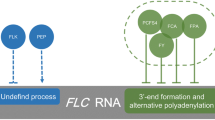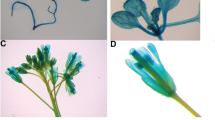Abstract
An early flowering mutant of Arabidopsis, elf32-D was isolated from activation tagging screening. The mutant flowered earlier than wild type under both long day and short day conditions. The mutant phenotype was caused by overexpression of a Kunitz-type trypsin inhibitor gene (AtKTI1). The expression of AtKTI1 was detected in leaves, flowers, siliques and roots. In the vegetative state, no change of flowering integrator gene expression was observed for AtKTI1 overexpressing plants. In contrast, at the reproductive stage, its overexpression resulted in the down-regulation of FLC, a strong floral repressor which integrates the autonomous and vernalization pathways and also the up-regulation of FT and AP1, which are downstream floral integrator genes. It is probable that the AtKTI1 overexpression inhibits components of the flowering signaling pathway upstream of FLC, eventually regulating expression of FLC, or causing perturbations in plant metabolism and thus indirectly affecting flowering.






Similar content being viewed by others
Abbreviations
- AP1:
-
APETALA1
- KTI:
-
Kunitz-type trypsin inhibitor
- FLC:
-
FLOWERING LOCUS C
- FT:
-
FLOWERING LOCUS T
References
Abe M, Kobayashi Y, Yamamoto S, Daimon Y, Yamaguchi A et al (2005) FD, a bZIP protein mediating signals from the floral pathway integrator FT at the shoot apex. Science 309:1052–1056. doi:10.1126/science.1115983
Beynon R, Bond JS (1989) Proteolytic enzymes: a practical approach. IRL Press, Oxford University Press, New York
Blázquez MA, Weigel D (2000) Integration of floral inductive signals in Arabidopsis. Nature 404:88–892
Borner R, Kampmann G, Chandler J, Gleissner R, Wisman E, Apel K, Melzer S (2000) A MADSdomain gene involved in the transition to flowering in Arabidopsis. Plant J 24:591–599
Clough SJ, Bent AF (1998) Floral dip: a simplified method for Agrobacterium-mediated transformation of Arabidopsis thaliana. Plant J 16:735–743
Corbesier L, Vincent C, Jang S, Fornara F, Fan Q et al (2007) FT protein movement contributes to long-distance signaling in floral induction of Arabidopsis. Science 316:1030–1033
Glaczinski H, Heibges A, Salamini R, Gebhardt C (2002) Members of the Kunitz-type protease inhibitor gene family of potato inhibit soluble tuber invertase in vitro. Potato Res 45:163–176
Grennan AK (2006) Variations on a theme. Regulation of flowering time in Arabidopsis. Plant Physiol 140:399–400
Halliday KJ, Koornneef M, Whitelam GC (1994) Phytochrome B and at least one other phytochrome mediate the accelerated flowering response of Arabidopsis thaliana L. to low red/far-red ratio. Plant Physiol 104:1311–1315
Kim JY, Park SC, Kim MH, Lim HT, Park Y, Hahm KS (2005) Antimicrobial activity studies on a trypsin-chymotrypsin protease inhibitor obtained from potato. Biochem Biophys Res Commun 330:921–927
Koornneef M, Alonso-Blanco C, Peeters AJ, Soppe W (1998) Genetic control of flowering time in Arabidopsis. Annu Rev Plant Physiol Plant Mol Biol 49:345–370
Kotchoni SO, Larrimore KE, Mukherjee M, Kempinski CF, Barth C (2009) Alterations in the endogenous ascorbic acid content affect flowering time in Arabidopsis. Plant Physiol 149:803–815
Lee H, Suh SS, Park E, Cho E, Ahn JH et al (2000) The AGAMOUS-LIKE 20 MADS domain protein integrates floral inductive pathways in Arabidopsis. Genes Dev 14:2366–2376
Leo FD, Bonade-Bottino MA, Ceci LR, Gallerani R, Jouanin L (1998) Opposite effects on Spodoptera littoralis larvae of high expression level of a trypsin proteinase inhibitor in transgenic plants. Plant Physiol 118:997–1004
Levy YY, Dean C (1998) The transition to flowering. Plant Cell 10:1973–1990
Li J, Brader G, Palva ET (2008) Kunitz trypsin inhibitor: an antagonist of cell death triggered by phytopathogens and fumonisin B1 in Arabidopsis. Molecular Plant 1:482–495
Macedo MLR, Freire MGM, Martins LT, Martinez DS, Gomes VM et al (2004) Novel protein from Labramia bojeri A. DC. seeds homologue to Kunitz-type trypsin inhibitor with lectin-like properties. J Agric Food Chem 52:7548–7554
Major IT, Constabel CP (2008) Functional analysis of the Kunitz trypsin inhibitor. Plant Physiol 146:888–903
Marchetti S, Delledonne M, Fogher C, Chiaba C, Chiesa F et al (2000) Soybean Kunitz C-II and PI-IV inhibitor genes confer different levels of insect resistance to tobacco and potato transgenic plants. Theor Appl Genet 101:519–526
Martinez-Zapater JM, Coupland G, Dean C, Koornneef M (1994) The transition to flowering in Arabidopsis. In: Meyerowitz EM, Somerville CR (eds) Arabidopsis. Cold Spring Harbor Laboratory Press, Cold Spring Harbor, NY, pp 403–411
McCoy AJ, Kortt AA (1997) The 1.8 angstrom crystal structure of winged bean albumin 1, the major albumin from Psophocarpus tetragonolobus (L) DC. J Mol Biol 269:881–891. doi:10.1006/jmbi.1997.1067
Michaels S, Amasino R (1999) FLOWERING LOCUS C encodes a novel MADS domain protein that acts as a repressor of flowering. Plant Cell 11:949–956
Miller G, Suzuki N, Rizhsky L, Hegie A, Koussevitzky S, Mittler R (2007) Double mutants deficient in cytosolic and thylakoid ascorbate peroxidase reveal a complex mode of interaction between reactive oxygen species, plant development, and response to abiotic stresses. Plant Physiol 144:1777–1785. doi:10.1104/pp.107.101436
Mouradov A, Cremer F, Coupland G (2002) Control of flowering time: interacting pathways as a basis for diversity. Plant Cell 14:S111–S130
Park Choi BH, Kwak JS, Kang CW et al (2005) Kunitz-type serine protease inhibitor from potato (Solanum tuberosum L. cv. Jopung). J Agric Food Chem 53:6491–6496
Saleh A, Alvarez-Venegas R, Avramova Z (2008) Dynamic and stable histone H3 methylation patterns at the Arabidopsis FLC and AP1 loci. Gene 423:43–47
Samach A, Onouchi H, Gold SE, Ditta GS et al (2000) Distinct roles of CONSTANS target genes in reproductive development of Arabidopsis. Science 288:1613–1616
Schuler TH, Poppy GM, Kerry BR, Denholm I (1998) Insect-resistant transgenic plants trends. Biotechnol 16:168–175
Sheldon CC, Burn JE, Perez PP, Metzger J, Edwards JA et al (1999) The FLF MADS box gene: a repressor of flowering in Arabidopsis regulated by vernalization and methylation. Plant Cell 11:445–458
Thompson JD, Gison TJ, Plewniak F, Jeanmougin F, Higgins DG (1997) The CLUSTAL X windows interface: flexible strategies for multiple sequence alignment aided by quality analysis tools. Nucleic Acids Res 25:4876–4882
Turck F, Fornara F, Coupland G (2008) Regulation and identity of florigen: FLOWERING LOCUS T moves center stage. Annu Rev Plant Biol 59:573–594
Weigel D, Ahn JH, Blazquez MA, Borevitz JO, Christensen SK et al (2000) Activation tagging in Arabidopsis. Plant Physiol 122:1003–1013
Wigge PA, Kim MC, Jaeger KE, Busch W, Schmid M et al (2005) Integration of spatial and temporal information during floral induction in Arabidopsis. Science 309:1056–1059
Wilson RN, Heckman JW, Somerville CR (1992) Gibberellin is required for flowering in Arabidopsis thaliana under short days. Plant Physiol 100:403–408
Acknowledgments
We thank Dr. G. Choi (KAIST, Korea) for the gift of the activation tagging mutant pool. We also thank Dr. Jason Reed (UNC, Chapel Hill, NC, USA) for critical reading of the manuscript. This work was supported by the Korea research Foundation Grant (KRF-2004-202-C00492) funded by the Korea Government (MOEHARD) to K.-H. Im.
Author information
Authors and Affiliations
Corresponding author
Rights and permissions
About this article
Cite this article
Kim, Jg., Baek, SA. & Im, KH. Overexpression of a Kunitz-type trypsin inhibitor (AtKTI1) causes early flowering in Arabidopsis. Plant Growth Regul 59, 75–81 (2009). https://doi.org/10.1007/s10725-009-9389-5
Received:
Accepted:
Published:
Issue Date:
DOI: https://doi.org/10.1007/s10725-009-9389-5




